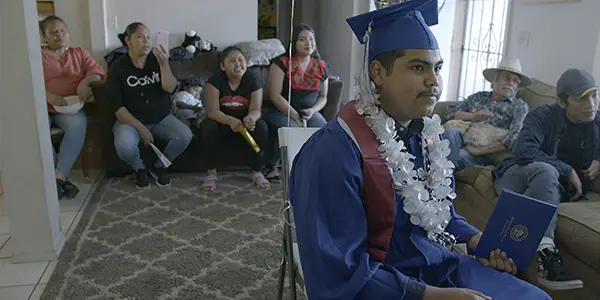San Francisco International Film Festival Documentary Round-up Part 2

Arlin is an all-around film person in Oakland, CA. He…
Well, we did it. Though I truly missed the excitement of racing from theater to theater and subsisting mostly on box candy and takeout, another successful marathon of the latest in non-fiction film making is in the books. With the shift to virtual, it seems that not only have festival programs generally shrunk but as audiences grow from regional to national the competition for premieres and exclusivity has become even more intense. Whereas in the before-times one could expect the majority of the big and buzzy docs to make a stop through the Bay Area, this year many of those films have already virtually premiered elsewhere. This meant this year’s SF FILM Fest was able to highlight some lesser-seen work, to varying degrees of success.
I noticed some themes throughout the documentary selections, as there were a number of films that looked at problems in far-off lands, while our own much-troubled nation was explored mostly in the supposed opportunities it offers to immigrants. So too did there seem to be a preference for stories that focused on celebrated individuals, potentially at the expense of films about broader societal narratives or ones that reveled in our mundane common experience. Taken in tandem, this left me wondering what the program might be attempting to convey at a time when our own inadequacies have never been in sharper relief. It was a pleasure to engage with these works brought to us by the sweat and passion of the SF FILM team, and I’m looking forward to getting vaccinated and (knock-on-wood) seeing what next year’s return to theaters will bring. (Note: some capsules were limited to 75 words)
Seyran Ateş: Sex, Revolution and Islam (dir. Nefise Özkal Lorentzen)

While Lorentzen certainly chose an interesting figure to profile, I found the treatment in this film to be one lacking in context. The film seemed content to present the important work Ateş undertakes, mostly leaving out the whys and hows that led her to undergo such a bold and brazen life’s work. This even manifested in the film’s aesthetics, as when Ateş leads a discussion group but is framed on her own, turning a conversation into a series of soliloquies, rather than a dialogue. I would call Sex, Revolution, and Islam lateral cinema, lacking momentum and failing to deliver on the promise of its enticing opening scene.
After Antarctica (dir. Tasha Van Zandt)

After Antarctica represents a strong feature debut for the Bay Area’s own Van Zandt, featuring some of the most breathtaking and arresting archival footage I can recall seeing in recent years. It’s so engrossing that I couldn’t help but feel anxious to return to it every time the film would switch gears to a more standard biographical profile of explorer Will Steiger, who led the harrowing expedition chronicled in the footage. Even so, After Antarctica has the potential for mass appeal, as it offers a compelling narrative of international cooperation and interpersonal admiration that could be used as a blueprint for any number of contemporary endeavors.
Poly Styrene: I am a Cliché (dir. Paul Sng & Celeste Bell)

This was probably the most frustrating film I watched at the festival, seeking to share the life of an endlessly fascinating and trailblazing artist, but unsure about how to effectively do so. The method chosen was to make Poly Styrene’s daughter, the co-director, writer, and producer, the film’s narrative backbone, and the lens through which the audience would come to learn about her mother. Celeste was the only person featured in new segments shot for the film (the rest of I am a Cliché is made up of archival materials and interviews recorded for the book “Dayglo”) in a notable lack of self-awareness that makes it difficult to take this film any other way than as a vanity project.
The Spokeswoman (dir. Luciana Kaplan)

Contrary to what the title might suggest, The Spokeswoman resists the easy trap of zeroing in on a central figure who represents a movement. Instead, Kaplan uses the campaign of Mexico’s first indigenous female candidate for president as an entree into a study of the ways in which disparate indigenous communities are collaborating in a continuing struggle for self-determination. In the process, official corruption is revealed as Marichuy lays the foundation for fights ahead.
Zumiriki (dir. Oskar Alegria)

This was undoubtedly the least inviting doc in the program this year, asking viewers to join the filmmaker in solitude as he lives in a cabin he built in the woods. If you’re willing to meet Zumiriki on its own terms it does offer some nice moments of natural beauty, such as when a rock is lifted to reveal a small frog living underneath. Other than that though this work of autobiographical essay filmmaking borders on the solipsistic without offering any real revelations, personal or otherwise.
Writing With Fire (dir. Sushmit Ghosh & Rintu Thomas)

Chronicling the work of Khabar Lahariya, a newspaper staffed by Dalit women, Writing With Fire presents journalism at its most harrowing. Those working under chief reporter Meera Jatav all flaunt personal risk, as well as some local journalistic conventions, in order to reveal injustice and corruption in their communities. Ghosh and Thomas deftly spread their focus across a few of the reporters, ranging in their levels of experience, to highlight the growth fostered under this nurturing yet rigorous environment.
Homeroom (dir. Pete Nicks)

The concluding installment of Nick’s trilogy on Oakland institutions sees the director yet again having to adapt to outside circumstances hijacking his film’s narrative. Documenting some members of Oakland High’s class of 2020 in their senior year, the film mostly resists teachers and administrators, instead of showing how these students exist on the vanguard of public discourse, and the extraordinary events it takes for their voices to be acknowledged and demands acted upon.
Cruz (dir. Teresa Camou Guerrero)

A late addition to this year’s program, Cruz paints a devastating portrait of displacement, focusing on an agricultural community forced from their homes by cartels seeking to use the land for poppy plants. Employing a mix of interviews with more poetic footage of abandoned houses, traditional dances, and sprawling poppy fields, the film makes it impossible to escape the trauma and longing these families are undergoing. But it also offers reasons for optimism, as culture is foregrounded as the way “home” continues on separate from land.
Does content like this matter to you?
Become a Member and support film journalism. Unlock access to all of Film Inquiry`s great articles. Join a community of like-minded readers who are passionate about cinema - get access to our private members Network, give back to independent filmmakers, and more.
Arlin is an all-around film person in Oakland, CA. He received his BA in Film Studies in 2010, is a documentary distributor and filmmaker, and runs Drunken Film Fest Oakland. He rarely dreams, but the most frequent ones are the ones where it's finals and he hasn't been to class all semester. He hopes one day that the world recognizes the many values of the siesta system.













